Letchworth State Park waterfalls at half speed
Same video at half speed. More relaxing.

Same video at half speed. More relaxing.
My dad, persistently frustrated by cheap cameras, would be amazed by what you can do with something that fits into your pocket. He would be more amazed and likely appalled by how much such a thing costs. I know he’d envy my photos and videos of Letchworth, though. From late May 2015.
Facebook has many flaws, but it does alert me when events I might be interested in are coming up. A few weeks ago I found out about the world premiere of Octave Chanute: Patron Saint of Flight, at Indiana Dunes Visitor Center. I knew the Chanute name vaguely from the old Air Force base, but I couldn’t have told you then where the base had been located or why it was named Chanute. This sounded like a way to get in a visit to Indiana Dunes, learn something, and spend what might be otherwise a dull winter afternoon, depending on the weather.
The parking lot was unusually crowded, and when J and I walked in about a half hour early, a good-sized group was watching Shifting Sands: On the Path to Sustainability, a documentary on the history of Indiana Dunes and efforts to restore what can be restored. It’s meant to inspire, but it’s also tragic and depressing.
By the time Shifting Sands ended and Octave Chanute was scheduled to begin, the auditorium had filled up, even when extra folding chairs were brought out. Soon it was standing room only.
Simine Short, author of Locomotive to Aeromotive: Octave Chanute and the Transportation Revolution, and young director Paul Nelson introduced the film. I mention Nelson’s relative age because the audience was mostly 50 plus, possibly 60 plus, which disappointed me because I would like to see younger people interested in history. Of course, when I was younger none of my peers would have been interested, either.

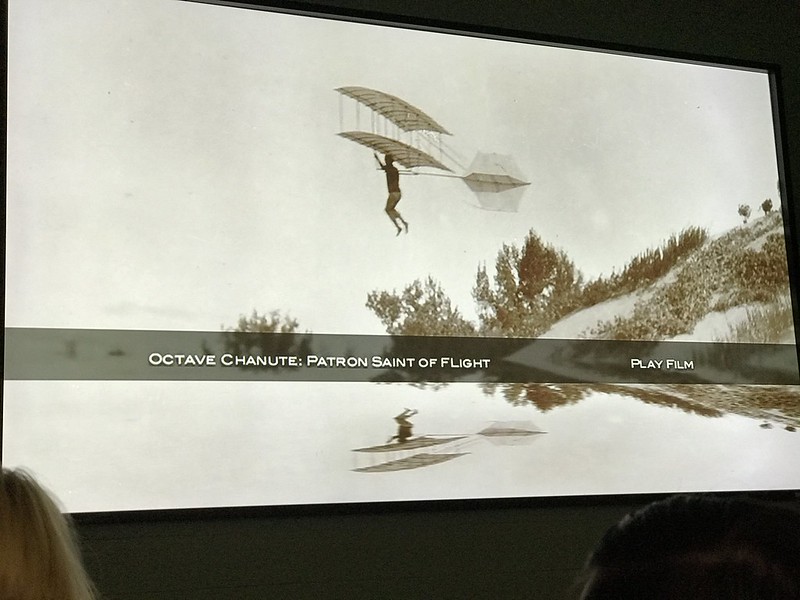
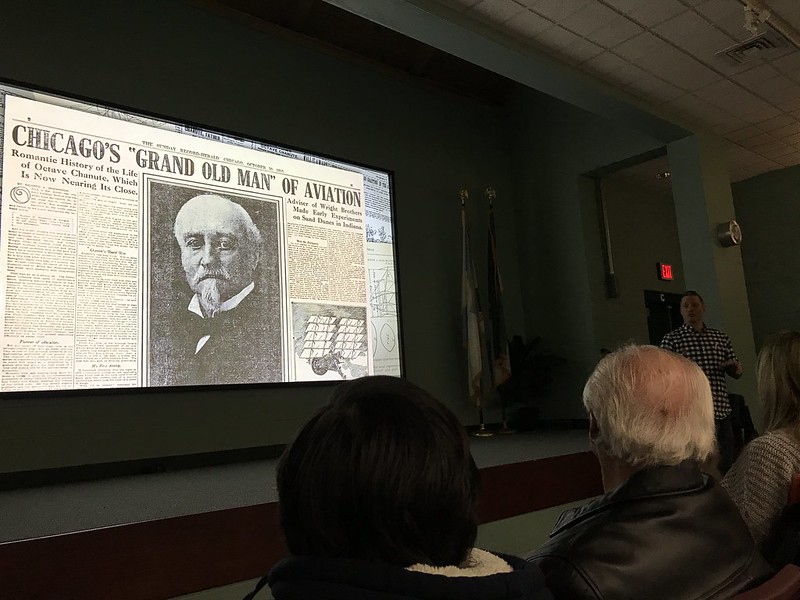
The presentation began with some technical glitches (flashbacks to every high school A/V club everywhere!), but my ears perked up at the mention of the Portage Bridge, accompanied by a photo I recognized immediately. Through this film, I found out Octave Chanute was the engineer behind the much-loved railroad bridge over the Genesee River at Letchworth State Park in New York.
Known for his bridges, Chanute was called in when the original timber trestle, the longest and tallest wooden bridge in the world when it opened in 1852, was reduced to ashes on May 6, 1875, after a train had passed over (spark?). Chanute’s iron replacement opened only 86 days after the fire. According to Short’s book, the piers were rebuilt and the uprights and girders strengthened in 1880, “making the bridge better than new.”

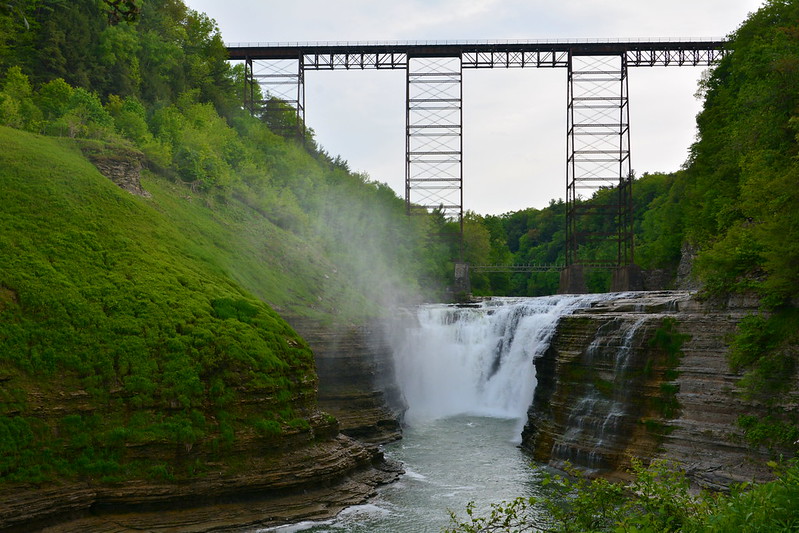

Although modern Norfolk Southern trains were restricted to 10 miles per hour over the Letchworth gorge, Chanute’s bridge lasted until 2017, when the Genesee Arch Bridge opened. The state of New York declined the offer of the 1875 bridge, the last of which was demolished on March 20, 2018. I’d been fortunate to visit the old bridge one last time in 2015. When I’d found out about the premiere of this film, I’d had no idea it would take me back to perhaps the most iconic of my childhood memories. I remember walking along those tracks with my brother during one of his visits.
But wait! There’s more!
My ears perked up again at the mention of Kinzua Bridge. I’d found out about Kinzua Bridge State Park when I was looking up Kinzua Dam, another place I’d visited as a child, for my 2015 swing through Ohio, New York, and Pennsylvania.
It turns out that Octave Chanute was behind the original 2,000-foot-long Kinzua Bridge (or Viaduct), built in 1882 at 302 feet above the narrow valley floor. Short calls it Chanute’s “most spectacular bridge.” She adds that the bridge was rebuilt in 1900 “to keep up with the increasing volume and weight of the coal traffic.” Carl W. Buchholz redesigned the superstructure on the original masonry foundation piers.
By 1959 the viaduct failed safety inspections and was closed to commercial rail traffic. Restoration began in 2002, but in 2003 an F2 tornado “tore eleven towers from their concrete bases. Investigators found that the anchor bolts, installed under Chanute’s supervision, had rusted over the past 120 years.” Over time, the materials had failed the design.
After seeing this film, I’m even happier that I had the opportunity to walk out on what’s still standing of Kinzua Bridge and get a look at the remnants resting in peace on the valley floor. Even destroyed, Kinzua Bridge is indeed a “spectacular” sight.
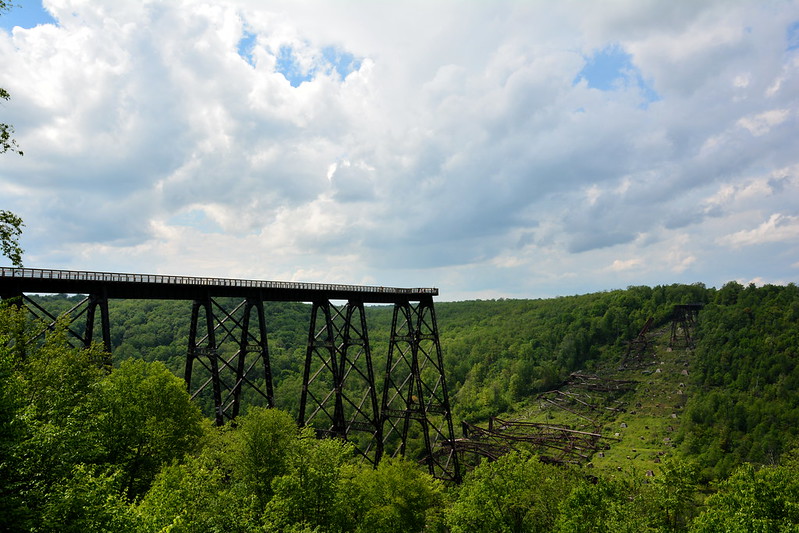
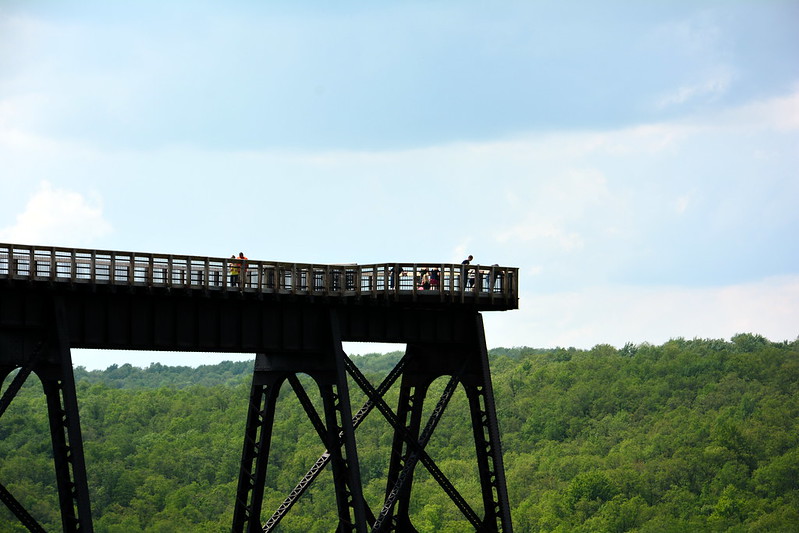
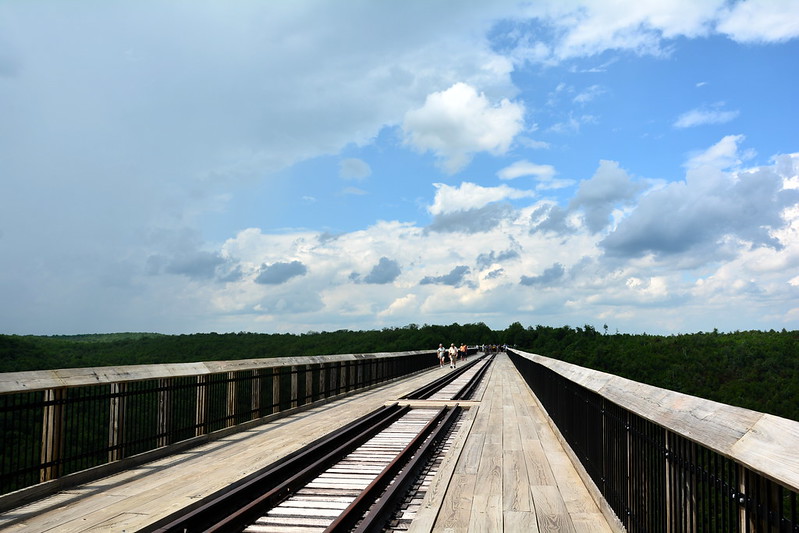

Of course, most of the film was about Chanute’s contributions to flight and relationship with Wilbur Wright (rocky; Chanute was an open source kind of man and Wilbur believed in closely held information). What’s the link to Indiana Dunes? With their lake winds, elevations, and soft sand, the Dunes were Chanute’s choice for safely testing their experiments — the Kitty Hawk of the Midwest.
Octave Grill in Chesterton is named for Octave Chanute. Found out they serve a Chanute burger.

I started the morning out with a bang by falling hard in the Jacuzzi bath that I’d enjoyed so much — I knew I’d brought those spa shoes with treads along for a reason.
As this was the last day at Temple Hill, our host gave us a peek at the pool and garden area, complete with a Japanese tea house under renovation.
After saying goodbye, we took ourselves to a nearby laundromat to freshen the wardrobe and killed the waiting time by going to Wegman’s, a favorite of some of my friends (who wouldn’t love a place that carries Uncle Ralph’s Magic Sauce?) and Yoberry Yogurt. After the laundromat we made what I was sure was our final stop at a Tim Horton’s.
Temple Hill is across the road from an old cemetery that is still in use, so we walked through for a bit, long enough for me to spot the grave of a former New York governor. I also found a child’s grave marked by a flat, broken, worn tombstone at the base of a tree, half covered by dirt. Others had fallen over and broken. Earth to earth, ashes to ashes, dust to dust indeed.
This time we didn’t go through Letchworth but along its western edge. We spied a place where it looked like maple syrup might be available, but when we went in, we found a very musty old barn that seemed to be a half-abandoned disordered mess. I imagine it’s haunted at night by wheezing asthmatic ghosts. No one at the nearby house came out, but a neighbor pulled into the driveway across the road and tried not to give us stink eye.
This time I went into the Glen Iris Inn gift shop, relieving them of more postcards than was necessary, then we explored the museum, which I remember vaguely.
Although it was a little out of the way, I had J. return to the Wolf Creek picnic area so I could regret leaving it a second time, this one for good.
We settled in at the Glen Iris Inn for a leisurely dinner followed by farewell visits to the Middle Falls and the old railroad trestle, around which ground has been cleared of trees for construction of the new bridge.
Reluctantly, as always, we turned southward toward Coudersport, Pennsylvania, and Frosty Hollow Bed and Breakfast. Along the way we stopped at a grocery store where I asked one of the shoppers the way to the facilities. She pointed toward the back to my right, but a few moments later ran after me and said she was wrong; it’s near the deli. I couldn’t find it there, so I asked a woman working there. Next thing I knew, she was leading me into the “back of the house” to the room the employees use. I thanked her, adding that I could never have found it on my own. She smiled brightly, saying, “Always ask an employee!” I began to feel like I was in a disjointed dream.
When we passed through Belmont, J. asked me to make a note — he liked it. Small-town New York retains a certain quaint vintage look that, if it ever existed in Chicago, was likely destroyed by the Great Fire and suburbanization. We crossed back into Pennsylvania, passed through Coudersport, and arrived at Frosty Hollow Bed and Breakfast at around 10 p.m. for the final leg of this eastern adventure. We were in the Pennsylvania Wilds.
A moment of serenity and bliss at Wolf Creek at Letchworth State Park in western New York.
Because we were the only guests at Temple Hill Bed and Breakfast, we were treated to breakfast al fresco on the deck overlooking the back lawn. It was so perfect that I hated to leave. We had to get an eyeglass repair kit (can’t have a driver who can’t see), then stopped at Byrne Dairy for me to look around and then Cricket’s Coffee Company because neither of us can resist a good coffee shop. We scored some condiments, including mustard and nut butters.
Eventually we tore ourselves away to return to the park, where we stopped at several of the overlooks. At one I read a sign pointing out a barely visible waterfall below and noting that another of four waterfalls could be seen at the Wolf Creek Picnic Area, so we had to go there too. From a pedestrian bridge over Wolf Creek, you can see a series of teeny drops along the creek bed, like miniature Niagaras, with the road bridge in the background. In an instant Wolf Creek evoked memories of sunbeams interrupted by shadows playing over rocks and drops as I walked along the creek bed without a care at Chestnut Ridge Park during a church picnic. Wolf Creek became a surrogate for one of the richest of my childhood experiences.
The real waterfall, the most visible of the series mentioned on the sign, drops on the other side of the pedestrian bridge. I don’t remember seeing Wolf Creek with my parents, but then there is so much that I don’t recall.
J. satisfied some of his shopping urges at the Glen Iris Inn, where we spent a long time taking photographs of the Middle Falls, which many believe are the most scenic of the park’s three major waterfalls. It’s funny that I recall the falls, but not the inn. I am sure that one day Virgil and I and possibly my aunt walked along the rail line if not part of the trestle.
Instead of driving back through the park as we had the day before, we passed along its eastern edge, where the roadside sported horse-and-buggy signs indicating that it’s Amish country. It’s a lovely rural drive and on this day the robin’s egg blue sky was punctuated by amazing clouds that I couldn’t quite capture.
Our destination was the North Shore Grill on Lake Conesus in Lakeville, giving us an opportunity to see one of the Finger Lakes (if only the smallest). There’s nothing like enjoying a great meal and drinks outdoors on a lake shore around sunset. I walked to the end of the dock to take all of it in — if only I could take all of it with me.
After another sumptuous breakfast, we left for Letchworth State Park, which has a fascinating history that includes the abducted Mary Jemison and business mogul William Pryor Letchworth. It’s amazing to me to imagine places like Matthiessen State Park (Illinois), Morton Arboretum (Illinois), and Letchworth State Park (New York) in private hands. Can you picture waking up every morning and strolling to your private waterfalls and/or along your stretch of a river?
First we stopped at Mount Morris Dam and one of the gifts shops, where I spent an alarming amount on books and postcards. They even have the vintage-looking wooden postcards, which can be mailed for extra postage. We sat in the picnic area to try a treat and just to soak in the day. When New York weather is good, it’s wonderful.
I remember Mount Morris Dam vaguely. It looked dry around it. In 1972, Hurricane Agnes dumped a massive volume of rain on Pennsylvania and western New York — that’s when I learned hurricanes from the south could affect us so far inland. Mount Morris Dam, completed in 1954, was pushed beyond its limits (some water was released to avoid the river pouring over the top), but without it much of Rochester may have ended up flooded (or in Lake Ontario?).
We continued driving south through the park, stopping at the Gardeau Overlook and at the Lower Falls Restaurant for a leisurely, relaxing lunch.
Next we tackled the Lower Falls Trail, which is supposed to have 127 steps, although some people who were returning told us they’d counted at least 128. I can’t say an extra step makes a difference unless it’s exceptionally steep (a couple were). I can manage, albeit slowly and sometimes with a helping wrist.
Of the three major waterfalls on the Genesee at Letchworth, the Lower Falls are said to be the least scenic. You can cross a bridge over the river to get a better look at the falls and Tea Table Rock, which some people walked onto. On the other side, water drips down from the rocks with slippery mud underneath, making it a great place to stand on a warm day. J. went a little past the bridge, but I was trying to save my energy for the walk back and my knees for the 127/128/1XX steps up. I haven’t looked up how far the trail goes, but with more time and energy I imagine we could have seen much more. I can’t say for sure that I’d ever seen the Lower Falls or been to the restaurant before — perhaps, perhaps not.
At Inspiration Point, the views of the gorge are especially spectacular. Fortunately for us, William Pryor Letchworth was a generous man with foresight who wanted to preserve the gorge from a particularly grisly future subject to the whims of industry, economics, and greed. I’ll have to read more about the history of Letchworth in the books I spent my vacation money on.
J. also got his first look at the Upper Falls with the railroad trestle passing above them. This bridge, in place since 1875, is being replaced by an updated design that won’t have piers in the gorge. I’m glad I could see the old bridge one more time and now wish I’d walked it. I am sure my brother and I walked along part of it once, long ago on a beautiful day, surrounded by trees, sun, and shadows.
As it was Memorial Day, little was still open by the time we were ready to eat, so we went to Mama Mia in downtown Geneseo for doughy, cheesy food right before the rain that had been threatening finally let loose.